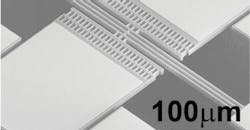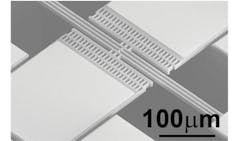Mechanical “Frequency Comb” Responds to Signals in an Entirely New Way
A team led by scientists at the Center for Nanoscale Materials (CNM) located in Argonne National Laboratory have developed a device that could improve a range of electronics. Their micromechanical resonator responds to external signals in an entirely new way.
“The novelty here is if you excite this resonator in the right way, it vibrates with a spectrum consisting of several evenly spaced frequencies, in spite of the fact it is driven by a single frequency,” says team leader Daniel Lopez.
A typical resonator in an electronic device responds to a signal with a corresponding frequency. In wristwatches, for example, a quartz resonator vibrates at a specific frequency when a certain voltage is applied, and that vibration is used to mark the time. But a multitasking network of devices might require responses at more than one frequency. That’s where things get tricky.
“For every device running at a specific frequency, you need a timing source,” says Argonne nanoscientist Dave Czaplewski. “Multiple devices running at multiple frequencies makes the network much more complex.”
This scanning electron micrograph shows a microelectromechanical resonator. The resonator three silicon beams are clamped at both ends. The center of the beams are connected to two comb drives for actuation and motion transduction. The fundamental vibration of the beam is in the plane of the comb drives. However, at higher frequencies, the resonator can move with a twisting motion around the center beams. When these two vibrational motions interact, a periodic motion can be induced with a spectrum consisting of many equally-spaced frequencies. (Credit: Argonne National Laboratory)
A common solution to this problem involves the use of several resonators, several signals, or both. In this case, the researchers created a single, small resonator that generates several frequencies from one signal. This set of frequencies is called a frequency comb, named for the way frequencies appear evenly spaced, like teeth, when plotted on a graph. So with this you could fabricate a single oscillator that generates a signal at all the different frequencies needed instead of making a specific oscillator for each device.
The silicon device is no bigger than a few grains of salt laid end to end. It consists of three beams anchored together that move together in two vibrations: a side-to-side swaying motion and a twisting motion.
“We used the interplay between those two vibrations to obtain this frequency response that ends up looking like a frequency comb,” Czaplewski said.
Frequency combs are more commonly used in optics, where they consist of laser light pulses and are used to accurately measure time. This new mechanical comb could find use in the studying a dynamic known as a SNIC bifurcation (saddle node on an invariant circle) in mechanical, optical, and biological systems.
“In a biological setting, for example, understanding this behavior could help scientists design MEMs elements that mimic the way neurons respond to stimuli,” he added.
The next step in the research, Lopez said, will be to reproduce the frequency comb phenomenon in higher-frequency resonators and extend the number of “teeth”—or frequencies—that can be generated.


